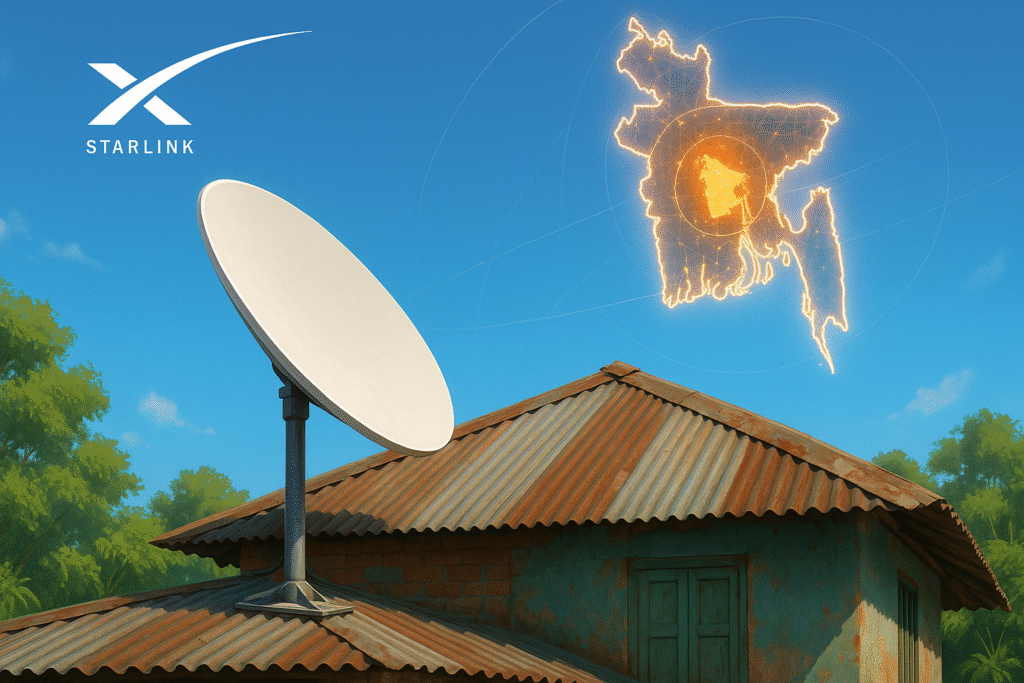If you are considering Starlink Bangladesh, it is crucial to understand the full picture. Bangladesh has made headlines by granting the license to Starlink, the satellite-internet service operated by SpaceX, making the country one of the first in South Asia to do so. (The Daily Star) At its core, Starlink offers fast, low-latency internet from satellites in low Earth orbit (LEO). However, a few major steps and costs stand between you and full setup.
Regulatory Milestones for Starlink Bangladesh
The first step for Starlink’s entry was regulatory approval. The Bangladesh Telecommunication Regulatory Commission (BTRC) issued licences to Starlink under its “Non-Geostationary Orbit (NGSO) Satellite Services” framework. (Developing Telecoms) On April 28, 2025, the Chief Adviser approved the licence, and Starlink obtained both the NGSO operator licence and the radio-communication apparatus licence. (Prothomalo) This cleared the way for commercial operation across the country.
How to Get Starlink Set Up in Bangladesh
Step 1: Check Service Availability
Visit Starlink’s website and select Bangladesh under your country or region. The system will check if your location is covered.
Step 2: Order the Hardware Kit
You must purchase the required hardware- a satellite dish (also called the terminal), tripod or mount, Wi-Fi router, and necessary cables. In Bangladesh the one-time hardware cost is roughly Tk 47,000 for the standard kit. (Dhaka Tribune) Some retailers list the kit from approximately Tk 26,500 for “mini” versions. (Star Tech)
Step 3: Choose a Subscription Plan
Two main residential plans are available:
- Residential Lite: about Tk 4,200 per month. (Dhaka Tribune)
- Residential: about Tk 6,000 per month for higher priority. (SAMENA Council)
Both plans offer unlimited data usage and download speeds up to 300 Mbps. (The Business Standard)
Step 4: Regulatory Declarations & Shipping
You’ll likely need to submit identification and address proof. Some reports say you’ll pay a shipping fee (~Tk 2,800) and provide a copy of your photo ID. (Prothomalo) After ordering, your kit may take 3-4 weeks to arrive.
Step 5: Install and Activate
Once your kit arrives, mount the dish in a clear view of the sky, plug in the equipment, and follow the Starlink app or portal for setup. You should get automatic network activation.
What It Will Cost You
Breaking down the numbers for Starlink Bangladesh:
- Hardware: approx Tk 47,000 one-time (Standard Kit).
- Monthly: Tk 4,200 for Lite or Tk 6,000 for full Residential.
- Some discounts for “mini” kits start around Tk 24,000-26,000. (Gadget & Gear)
- Unlimited data with up to 300 Mbps in many cases. (The Daily Star)
This pricing is higher than typical fibre in city areas, but the value lies in reliability, mobility and remote-area coverage.
Why Starlink Matters for Bangladesh
Starlink could transform Bangladesh’s digital landscape. With the licence approved, it brings a new high-speed option for underserved and remote regions. (The Financial Express) This is timely given Bangladesh’s terrain of islands, hill tracts and flood-prone zones. Also, resilient internet matters for business continuity, education and remote work. One expert noted the service offers an alternative that cannot easily be shut down or disrupted. (Reuters)
Challenges and Considerations
While the offering is promising, some caveats apply:
- High upfront cost means it may currently appeal more to premium users than mass market. (The Daily Star)
- Installation still requires a clear view of the sky, making inner-city or roof-less users more tricky to serve.
- Regulatory oversight in Bangladesh now includes interception guidelines for satellite internet. (Prothomalo)
- Competition from fixed-broadband and 5G services will remain strong; Starlink must prove value beyond speed.
Who Should Consider It
Starlink makes most sense for:
- Remote homes, islands, forest edge or hill areas lacking fibre infrastructure
- Freelancers, content creators or remote workers needing reliable high-speed internet anywhere
- Critical organisations (NGOs, disaster-response units, remote offices) needing guaranteed connectivity
For typical city users already on fibre, Starlink may still offer value but needs to be weighed based on costs and location.
The Future Outlook
With its 10-year operating licence, Starlink Bangladesh is positioned for long-term presence. (Anadolu Ajansı) Future kit versions, pricing reductions or EMI options could broaden access. Policy-wise, Bangladesh’s broadband spectrum and satellite regulation landscape may evolve further. Local partnerships and ground-station infrastructure could reduce costs and improve performance over time. Should competition increase, we may see new service tiers, rental hardware or shared-kit models emerge.
Starlink Bangladesh offers a bold alternative for high-speed, satellite-based internet in Bangladesh. The path involves regulatory approval, hardware purchase, monthly plans and installation. While upfront costs are non-trivial, the benefits for remote connectivity and resilient access are significant. For users in underserved areas or anyone prioritising mobility and reliability, this option stands out. That said, for mainstream users in well-connected cities, the value must be assessed carefully. Ultimately, Starlink adds a strong new element to Bangladesh’s digital infrastructure story.
